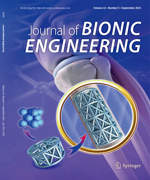This article provides an overview of the application of bionic technology in marine cruising equipment, discussing its research progress and future development trends. Marine cruising is a crucial means of gaining insights into the marine environment and conducting scientific research. However, conventional marine cruising equipment faces numerous challenges when dealing with complex and ever-changing marine environments. Bionic technology, as a means of drawing inspiration from the structure and functions of living organisms, offers new approaches and methods to address the challenges faced by marine cruising equipment and has found widespread application. The article primarily focuses on the applications and historical developments of bionic technology in propulsion methods, drag reduction, and surface antifouling. It summarizes the design principles, manufacturing techniques, and optimization methods for marine biomimetic cruising equipment. Finally, this paper analyzes the achievements, challenges, and future directions of bionic technology in marine cruising equipment. The application of bionic technology in marine cruising equipment holds vast potential for development, enabling us to better confront the challenges of marine exploration and research by drawing wisdom from nature and driving advancements in marine science.

 Table of Content
Table of Content
 Table of Content
Table of Content